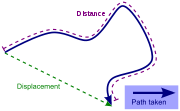.gif)
Displacement (vector)
Encyclopedia

Distance
Distance is a numerical description of how far apart objects are. In physics or everyday discussion, distance may refer to a physical length, or an estimation based on other criteria . In mathematics, a distance function or metric is a generalization of the concept of physical distance...
from the initial to the final position of a point P. Thus, it is the length of an imaginary straight path, typically distinct from the path actually travelled by P. A displacement vector represents the length and direction of that imaginary straight path.
A position vector expresses the position of a point P in space in terms of a displacement from an arbitrary reference point O (typically the origin of a coordinate system). Namely, it indicates both the distance and direction of an imaginary motion along a straight line from the reference position to the actual position of the point.
A displacement may be also described as a relative position: the final position of a point (
 ) relative to its initial position (
) relative to its initial position ( ), and a displacement vector can be mathematically defined as the difference between the final and initial position vectors:
), and a displacement vector can be mathematically defined as the difference between the final and initial position vectors:
In considering motions of objects over time the instantaneous velocity
Velocity
In physics, velocity is speed in a given direction. Speed describes only how fast an object is moving, whereas velocity gives both the speed and direction of the object's motion. To have a constant velocity, an object must have a constant speed and motion in a constant direction. Constant ...
of the object is the rate of change of the displacement as a function of time. The velocity then is distinct from the instantaneous speed
Speed
In kinematics, the speed of an object is the magnitude of its velocity ; it is thus a scalar quantity. The average speed of an object in an interval of time is the distance traveled by the object divided by the duration of the interval; the instantaneous speed is the limit of the average speed as...
which is the time rate of change of the distance traveled along a specific path.
The velocity may be equivalently defined as the time rate of change of the position vector. If one considers a moving initial position, or equivalenty a moving origin (e.g. an initial position or origin which is fixed to a train wagon, which in turn moves with respect to its rail track), the velocity of P (e.g. a point representing the position of a passenger walking on the train) may be referred to as a relative velocity, as opposed to an absolute velocity, which is computed with respect to a point which is considered to be "fixed in space" (such as, for instance, a point fixed on the floor of the train station).
For motion over a given interval of time, the displacement divided by the length of the time interval defines the average velocity
Velocity
In physics, velocity is speed in a given direction. Speed describes only how fast an object is moving, whereas velocity gives both the speed and direction of the object's motion. To have a constant velocity, an object must have a constant speed and motion in a constant direction. Constant ...
.
Rigid body
In dealing with the motion of a rigid bodyRigid body
In physics, a rigid body is an idealization of a solid body of finite size in which deformation is neglected. In other words, the distance between any two given points of a rigid body remains constant in time regardless of external forces exerted on it...
, the term displacement may also include the rotation
Rotation
A rotation is a circular movement of an object around a center of rotation. A three-dimensional object rotates always around an imaginary line called a rotation axis. If the axis is within the body, and passes through its center of mass the body is said to rotate upon itself, or spin. A rotation...
s of the body. In this case, the displacement of a particle of the body is called linear displacement (displacement along a line), while the rotation is called angular displacement
Angular displacement
Angular displacement of a body is the angle in radians through which a point or line has been rotated in a specified sense about a specified axis....
.
Derivatives
Velocity
Acceleration

Jolt/Jerk/Surge/Lurch

Snap/Jounce

Crackle

Pop/Pounce

Lock

Drop

Where
 is the position vector,
is the position vector,  is the velocity vector,
is the velocity vector,  is the acceleration vector,
is the acceleration vector,  is the jerk vector,
is the jerk vector,  is the snap vector,
is the snap vector,  is the crackle vector,
is the crackle vector,  is the pop vector,
is the pop vector,  is the lock vector, and
is the lock vector, and  is the drop vector.
is the drop vector.

